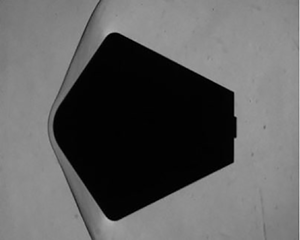Article contents
Hypersonic flow over spherically blunted cone capsules for atmospheric entry. Part 2. Vibrational non-equilibrium effects
Published online by Cambridge University Press: 06 January 2023
Abstract

Atmospheric entry capsules shaped as spherically blunted, large apex-angle cones are widely used in space missions. In Part 1 of this study (Hornung, Martinez Schramm & Hannemann, J. Fluid Mech., vol. 871, 2019, pp. 1097–1116) we explored flows over the two elements of the capsule shape, the sphere and the sharp cone with detached shock, theoretically and computationally. Using a large number of inviscid, perfect-gas computations, analytical functions of two independent variables, the normal-shock density ratio  $\varepsilon$ and a cone-angle parameter
$\varepsilon$ and a cone-angle parameter  $\eta$ (which is a function of
$\eta$ (which is a function of  $\varepsilon$ and the cone half-angle
$\varepsilon$ and the cone half-angle  $\theta$) were found for the dimensionless shock wave stand-off distance and the drag coefficient of a sharp cone. An analytical description was found for the shock stand-off distance in the transition from the 90
$\theta$) were found for the dimensionless shock wave stand-off distance and the drag coefficient of a sharp cone. An analytical description was found for the shock stand-off distance in the transition from the 90 $^\circ$ cone (flat-faced cylinder) to the sphere. In Part 1, it was speculated that the perfect-gas results have relevance to non-equilibrium situations if the normal-shock density ratio is replaced by the density ratio based on the average density along the stagnation streamline. In Part 2, the investigation is extended to blunted-cone capsule shapes. High-precision force measurements and schlieren image analysis are performed in the High-Enthalpy Shock Tunnel Göttingen (HEG) of the German Aerospace Centre using air as the test gas, at conditions where vibrational non-equilibrium effects are significant. Accordingly, results are compared with viscous numerical predictions using different physico-chemical models. A theoretical model is constructed for the density profile along the stagnation streamline that is determined by the free stream conditions and gives the average density. Comparisons of the experimental and numerical results for the dimensionless shock stand-off distance and the drag coefficient, with the extension of the analytical functions of Part 1 to vibrationally relaxing flow, exhibit very good agreement in all of a range of geometries.
$^\circ$ cone (flat-faced cylinder) to the sphere. In Part 1, it was speculated that the perfect-gas results have relevance to non-equilibrium situations if the normal-shock density ratio is replaced by the density ratio based on the average density along the stagnation streamline. In Part 2, the investigation is extended to blunted-cone capsule shapes. High-precision force measurements and schlieren image analysis are performed in the High-Enthalpy Shock Tunnel Göttingen (HEG) of the German Aerospace Centre using air as the test gas, at conditions where vibrational non-equilibrium effects are significant. Accordingly, results are compared with viscous numerical predictions using different physico-chemical models. A theoretical model is constructed for the density profile along the stagnation streamline that is determined by the free stream conditions and gives the average density. Comparisons of the experimental and numerical results for the dimensionless shock stand-off distance and the drag coefficient, with the extension of the analytical functions of Part 1 to vibrationally relaxing flow, exhibit very good agreement in all of a range of geometries.
JFM classification
Information
- Type
- JFM Papers
- Information
- Copyright
- © The Author(s), 2023. Published by Cambridge University Press
References
REFERENCES
- 6
- Cited by


